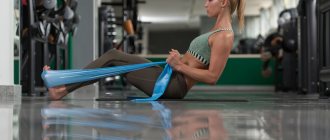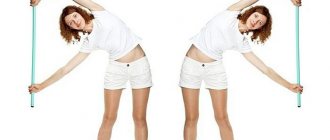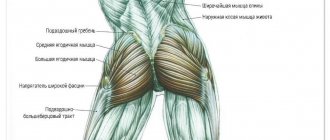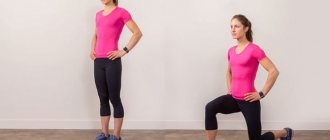Deadlift with a kettlebell is one of the variations of the basic exercise, aimed primarily at beginners, as well as girls. Unlike the classic version, the use of this projectile changes the center of gravity, which affects the distribution of the load.
Can be performed with either one or two weights. These two options are very different from each other and may well be called different exercises. When performed, they develop different muscle groups, so we will talk about them in turn.
What muscles are involved?
The deadlift with one kettlebell is practically no different from the classic version. It is also a basic exercise, the only difference being that the weight used here is not sufficient for active muscle growth.
It involves the following muscle groups:
- The main load will be taken by the back extensors. They are responsible for straightening the body and stabilizing its position.
- The legs, especially the buttocks and hamstrings, also make a significant contribution to the movement. They help to straighten the body and return it to its normal position. The quadriceps are also involved in the movement - they provide explosive force when straightening the knees from the bottom point.
- The arms and back receive a static load, holding the weight and preventing it from moving in space.
- In addition, the core muscles, as well as many other small muscle groups, play the role of stabilizers, helping to maintain balance and correct body position.
The double kettlebell deadlift combines the movements of the deadlift and the t-bar row, with the positive attributes of both.
With its help they develop:
- Muscles of the back and lumbar region - they are necessary to return the body to a vertical position.
- The buttock and hamstrings will receive more load in the double kettlebell version, since the exercise is performed on one leg, and, accordingly, they will require more effort to return the body to the correct position.
- While holding a horizontal position on one leg, the muscle groups of the lumbar region, abs and core, as well as the quadriceps, receive an impressive static load, even despite the use of light weight.
- To maintain this position, a huge number of small muscles are used as stabilizers. You yourself can feel how unstable your body position will be. The more often this option is practiced, the stronger the muscles responsible for balance will become.
- Holding weights in free-hanging arms strains and stretches the muscles of the arms, chest, and latissimus dorsi.
Pros and cons of the exercise
The single kettlebell deadlift is used because it is the same basic exercise as the classic deadlift. This option has the following advantages:
- It uses many joints throughout the body, which stimulates the body to increase testosterone production.
- Speeds up metabolism and triggers anabolic processes throughout the body.
- The shifted center of gravity partly transfers loads to the forearms and palm extensors. Thanks to this, this type of deadlift can strengthen and strengthen your grip much more effectively than other exercises.
- Improves coordination of movements and develops qualities necessary where jerking efforts are required.
- Returns tone to the muscles of the lumbar region, increasing their strength and endurance.
Deadlifts with two kettlebells are usually performed on one leg, which quite significantly changes the technique. This results in the following advantages:
- Improves coordination and balance, which can be useful in other types of training.
- Allows you to work out the gluteal region more thoroughly and deeply, as well as improve its relief.
- It is a safer option for the lower back, as part of the load is removed due to the use of the lever principle.
- Well develops and strengthens the arms - biceps, triceps, forearms and shoulders.
- Stretches all areas of the latissimus dorsi muscles.
- Practicing single-leg deadlifts allows you to more intensely work all the leg muscles, both quadriceps and biceps.
- The exercise develops the rigidity of the stance very well - performing such a movement on one leg is technically difficult. After some time, you will notice that it becomes much easier to do it than at first.
As with the classic version of the deadlift, this exercise is not recommended for people who have problems with the lower back or knee joints.
Another advantage of this exercise is that it can be included in a workout complex for home. All you need is one or two weights and some free space. Since these equipment are quite light in weight, you will only need to use an athletic belt if you have serious problems with your lower back.
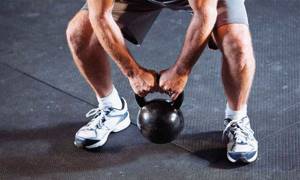
Types and technique of execution
There are a huge number of types of this exercise. Let us consider in detail the technique of performing each.
Classic deadlift
The technique is suitable for those who are working on gaining an athletic physique. It works all the muscle groups involved in the training (but mostly the trapezius and spinal extensors), allowing you to increase their volume if done correctly:
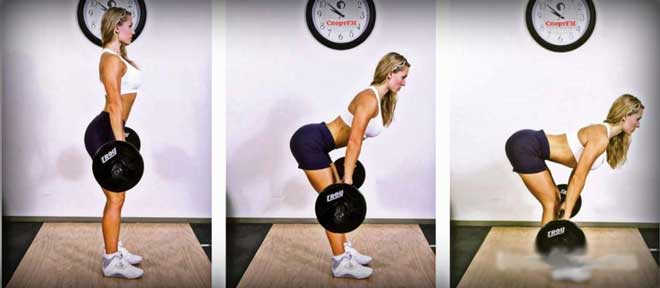
During execution, you need to ensure that your back is always straight and tense.
- Take a stance. To do this, place your legs slightly narrower than your shoulders, with your feet parallel.
- Perform an overhand grip on the barbell (it should be as close to your shins as possible, so it is recommended to wear leggings), placing your palms shoulder-width apart.
- Pull your shoulder blades and shoulders back slightly, tighten your abs.
- “Tear off” the barbell, tensing your quadriceps and buttocks.
- When she has completed 20-30% of the amplitude, begin moving her back, i.e. Fully straighten your spine and fix the pose at the end point.
- Start lowering the bar. During the action, the hips abduct first. When the bar is level with your cups, you can bend your knees and lower the weight.
Deadlifts with a snatch grip are recommended to be included in the training complex for those athletes whose back muscles predominate over their leg muscles. The classic style of execution is the main discipline in extreme strength and triathlon (powerlifting). This exercise is also included in the program by bodybuilders and fitness athletes.
Sumo deadlift
This technique is quite similar to the previous option. The differences lie in the width of the arms and legs. If in the classical variation the upper limbs are located shoulder width apart, then in the sumo style they are at a shorter distance from each other. The legs stand very wide, the toes are turned outward, almost touching the pancakes.
This exercise works the hips to a greater extent. It is recommended for athletes with weak backs and long arms.
Deadlift on straight legs - Romanian deadlift
This type of exercise is also called deadlift. Can be performed with straight legs. Sometimes bending them slightly is acceptable. Deadlift on straight legs has a fairly simple technique. This is not training for powerlifting. However, it works great on the hamstrings and gluteal muscles.
The essence of the movement lies in the neuromuscular connection, and not in lifting the maximum permissible weight. If during its execution you feel the work of the necessary muscles, then you should not increase the weight of the pancakes. This will prevent damage to the hamstrings.
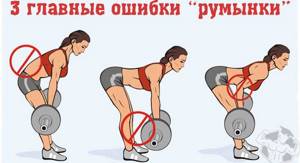
When performing the exercise, you are prohibited from lifting your feet off the floor; you must stand firmly on them.
During the exercise, it is desirable to keep your legs straight. If this is difficult to do, then you can bend your knees a little. The Romanian deadlift is performed by moving the buttocks back while maintaining a fixed back.
Smith machine deadlift
The Smith deadlift is considered one of the simplest techniques because:
- weight can be taken from different levels;
- you can fix it at any height if it becomes difficult;
- the weight moves only up and down, there is no risk of deviation to the side.
The exercise is performed in exactly the same way as outside the machine. The technique is suitable for athletes with back pain. If there are no health problems, then it is better to do the movement with free weight.
Deadlift with trap bar
In Russia, only a small number of gyms are equipped with a trap bar. This projectile allows you to work in a slightly different amplitude and increase strength indicators.
A trap bar is a diamond-shaped barbell. It has special grip handles. During the exercise, the palms are parallel to each other. The handles of the projectile are at the level of the body. Thanks to this, it is possible to keep your back straight throughout the entire training, which is not always possible with the classical variation.
Deadlift with dumbbells
When performing an exercise using dumbbells, it is possible to increase the amplitude, because... their bar is located lower than if a barbell were involved. This technique is often included in the CrossFit program. It can be combined with dumbbell push-ups or thrusters.
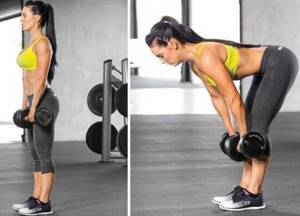
If you are afraid to start training with a barbell, then this exercise will be the best option.
The movement is similar to sumo, but the dumbbells are not placed on the floor. They need to be worked without stopping in the top position with a shortened amplitude. The adductor muscles should be in constant tension, the back should be straight.
There are several options:
- Single leg deadlift with dumbbells. The idea is that the weight is transferred to one lower limb. The second one is placed on the toe or completely lifted off the floor. The deadlift on one leg is done with maximum amplitude. The same number of repetitions must be performed on each limb.
- With front dumbbells. This technique is not suitable for those who have long legs and large hips.
- With side dumbbells. An alternative to the previous type for athletes with long legs.
It makes no sense to do this exercise with less than 10-15 repetitions, but with a large weight, since the goal is targeted muscle development, not strength records.
Number of approaches and weight
As with any exercise, these numbers depend on what your goals are. If you need to gain muscle mass, then you should do it in 3-4 sets of 12 repetitions. The repetitions should be performed slowly and under control without jerking.
If you want to work on definition and are working on drying, then you should do 4-5 sets of 15-20 repetitions. In this case, you need to use lighter weight equipment, and try to do the exercise as quickly as possible, but without compromising the correct technique.
Alternative Deadlift Exercises
The deadlift can be replaced with other exercises only if there are medical contraindications to this training. An alternative would be:
- pull-ups on the bar;
- hyperextension;
- reverse hyperextensions;
- abduction and extension of the lower limbs in the simulator.
In conclusion, I would like to add that this movement is not recommended to be done often (no more than 3 times a week). If you use too little weight to avoid damage, then the exercise will be of no use.
Technique for performing deadlifts with a kettlebell
- First of all, select a projectile of suitable weight.
- Hold it with both hands. The arms are not tense.
- Your back should be straight and your legs should be slightly wider than shoulder level. There is also a variant of the wide leg position - sumo, but it is used to work the buttocks.
- Lower yourself into a standard deadlift position. The knees are slightly pushed forward, the back is straight at an angle of approximately 45 degrees to the floor, the head is straight and the gaze is directed forward.
- When you reach the bottom, pause for a second.
- Rise up to the starting position, but do not straighten your knees completely.

Deadlifts with kettlebells on one leg are performed as follows:
- Stand straight, spread your feet shoulder-width apart, and hang your arms freely with weights.
- Tighten your abdominal and core muscles and don’t relax even for a moment.
- Bend your right leg at the knee and lean forward, while simultaneously bending your left leg back.
- The back should remain straight.
- Lower your body until it is parallel to the floor.
- Stay in this position for a second and return to the starting position.
- Repeat the same on your right leg.
The kettlebell deadlift is a great exercise to add to your home workout routine.
Of course, it does not use the same weight as in the case of a barbell, but it can have no less impact on the development of your muscles. Unless you see the same increase in muscle mass. Video Kettlebell deadlift in the gym
What you need for deadlift exercises
Correct positioning of the body and legs requires a good stretch of the lower back. When the muscles and ligaments are weakly stretched, an error often occurs when performing the exercise - rounding, arching of the lower back, which can lead to injury. In addition, the backs of your legs must be stretched to perform a stiff-legged deadlift. If the stretch has not yet reached the desired level, you will not be able to lower the weight or lift it correctly.
Do not perform this exercise if you have back pain.

